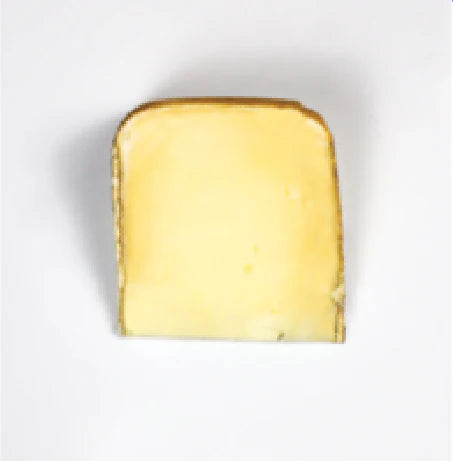PECORINO FOGLIE DI NOCE
Producer: SALCIS, imported exclusively by Rogers Collection

LOCATION & HISTORY
Tuscany is a region renowned for its historic Renaissance-era art, classic wines, and iconic cuisine. All over the boot, a key part of most Italian cuisine is cheese, and the medieval province of Siena is no different. During a visit to Siena, you might enjoy typical products such as pici, panforte, and of course, pecorino. Arguably the area’s most famous cheese, pecorino (meaning “sheep’s milk cheese” in Italian) comes in many forms and flavors. In fact, sheep provide the milk for 40% of all cheese produced in Italy! The milk for this Pecorino Foglie di Noce comes from the surrounding areas of Siena, including the famed Chianti region, the Orcia Valley, and the Crete Senesi, an arid area covered in soft, rolling hills and a mineral-rich clay-like sediment called “mattaione,” a remnant of the sea that once covered the land millions of years ago. The local herds of sheep who graze on the fragrant blend of herbs and flora that grow here produce milk that develops into a complex and deeply flavored cheese. SALCIS’s cheese is now made in a newer facility located at the foot of the Monteriggioni Castle, which was once referenced in Dante’s Inferno.
MAKE DESCRIPTION
To maintain the highest quality and cleanest flavor, the milk is processed within 24 hours of being collected and cheese production begins. After pasteurization, the rennet is added in multiple small vats to closely mimic traditional techniques. The curds are cut larger and stirred to release whey until they reach the size of hazelnuts, and then heated to release even more whey, until finally they reach the size of corn kernels. After being placed into the molds, the wheels are stacked and flipped as a pressing technique, which not only removes excess moisture, but also helps fuse the curds together in the molds in a process called knitting. As the name implies, Pecorino “Foglie di Noce” is aged in walnut leaves sourced from the SALCIS property, a traditional technique meant to preserve the cheese during the warmer months, but that also imparts a distinct nutty flavor during its 90 days of aging. The wheels are vacuumed sealed before being released for sale, which helps further infuse the wheel with the nutty flavors of the walnut leaves.
PRODUCER HISTORY
The Morbidi family settled just outside of Siena and opened a gastronomia (a specialty shop) in 1925, with the goal of offering a curated selection of food products typical of the Tuscan region. In 1941 during WWII, a group of Sienese butchers unionized, headed by Armando Morbidi, hoping to unify the cured meat producers in the area and create their own set of rigorous processing standards to uphold the region’s culinary traditions. SALCIS is an acronym for this union, and their first housemade product was a line of terroir-driven Tuscan charcuterie. In the 1960s, the Morbidi family helped to establish the local herds of sheep that were brought there from Sardegna, and thus began producing their own traditional pecorino. Their herd of about 1400 sheep provides around 30% of the milk needed for their production, and the rest of the milk is sourced from local farms in the surrounding area. In 2015, they built an environmentally “green” barn for their flock, made of hay bale walls and a grass roof.
Today, the farm is run by 3rd generation Morbidi siblings Armando and Antonio alongside cheesemaker Mauro, who has been with the company for 25 years, and shepherd Sergio, who has been maintaining their flock for the last 15 years and is the son of one of their original shepherds. Together, they continue to uphold the original Morbidi family goals — to carry on the culinary traditions of Siena and continuously strive for excellence in all aspects of the operation. The company philosophy is based in respect for the land and an understanding of how properly caring for the environment can produce the best quality raw materials that lead to the best quality products. The production of their cheeses helps to preserve the agricultural and gastronomic traditions of the region, which can be tasted in each bite of this Pecorino Foglie di Noce.
TASTING NOTES
Pecorino Foglie di Noce is usually consumed when it is semi-stagionato, or semi-aged. This younger profile has a supple, elastic texture and a sweet and milky flavor that is more gentle than the intense barnyard notes that are typical of the longer-aged profiles. The walnut leaves impart a subtle nutty flavor and a pleasant aroma reminiscent of a forest floor. For a true Sienese experience, drizzle with honey before enjoying.




